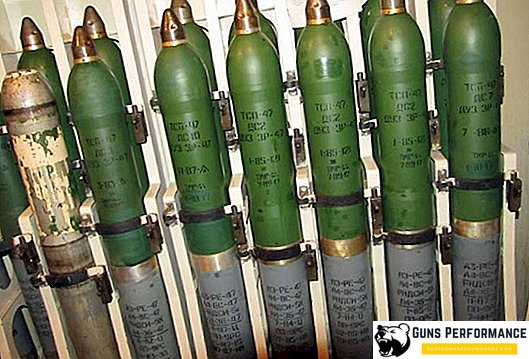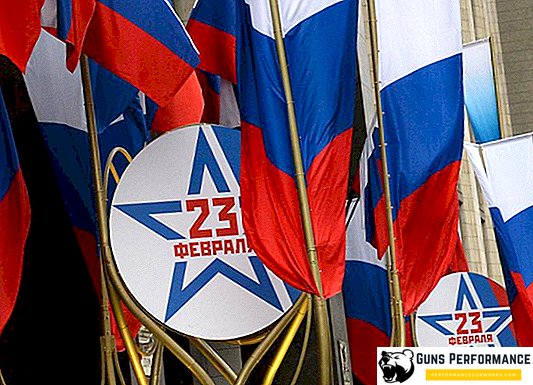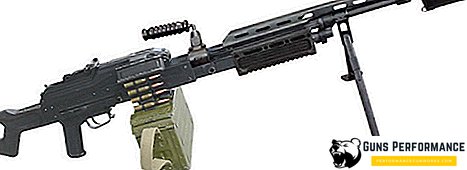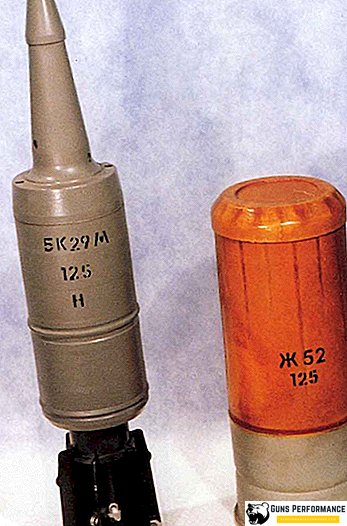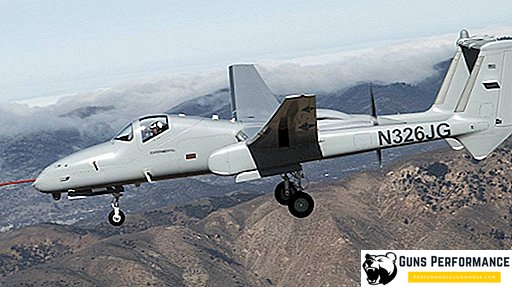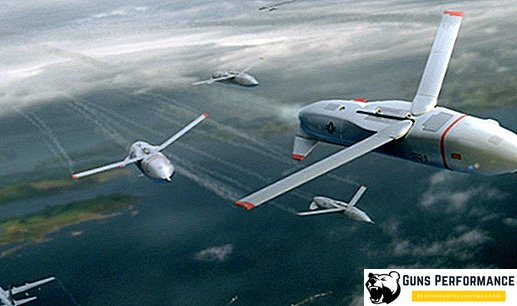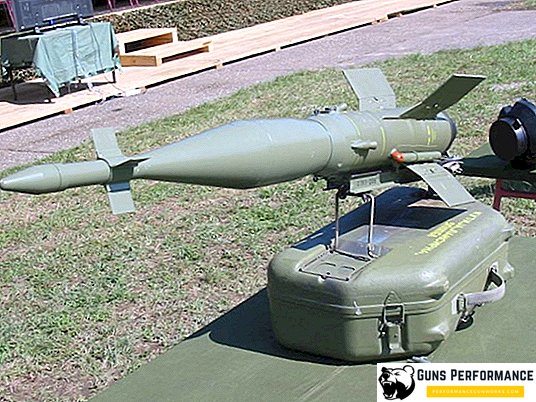
The Degtyarev submachine gun (PPD) is a Soviet submachine gun of 7.62 mm caliber, developed by the talented gunsmith Vasily Degtyarev in the early 30s of the XX century. The first modification of the Degtyarev submachine gun (PPD-34) was put into service in 1934, and the last (PPD-40) was commissioned in 1940.
PPD became the first Soviet serial submachine gun. Its production continued until the end of 1942. This weapon was actively used during the Soviet-Finnish war, as well as at the beginning of the Great Patriotic War. Later it was replaced by a cheaper and more advanced Shpagin submachine gun (PCA).

History of creation
Submachine guns appeared during the First World War. This weapon was supposed to significantly increase the infantry firepower, allowing it to withdraw from the "positional impasse" trench warfare. By that time, machine guns proved to be a very effective defensive weapon capable of stopping any enemy attack. However, they clearly were not suitable for offensive action. Machine guns of WWI had a very solid weight and most of them were easel. For example, the well-known Maxim machine gun weighed more than 20 kg (without water, cartridges and a machine tool), and together with the machine tool it weighed more than 65 kg. Machine guns of the First World War had a calculation from two to six people.
It is not surprising that the idea of arming infantry with a quick-fire weapon, which could easily be carried and used by one person, soon appeared. It led to the appearance of three types of automatic weapons at once: an automatic rifle, a light machine gun and a submachine gun that uses pistol cartridges for firing.
The first submachine gun appeared in Italy in 1915. Later, other countries involved in the conflict took up similar developments. Submachine guns did not have a big impact on the course of the PRC, but the design developments made during this period were used to create a number of successful samples of these weapons.
In the USSR, work on the creation of new submachine guns began in the mid-20s. Initially they planned to arm the junior and middle officers, replacing pistols and revolvers. However, the attitude of the Soviet military leadership to these weapons was somewhat dismissive. Due to low tactical and technical characteristics, submachine guns were considered “police” weapons, the pistol cartridge had low power and was effective only in close combat.
In 1926, the Red Army Artillery Directorate approved technical requirements for submachine guns. Not immediately was selected ammunition for a new type of weapon. Initially, submachine guns were planned to be chambered for 7.62 × 38 mm Nagan, but later preference was given to the Mauser cartridge 7.63 × 25 mm, which was actively used in the system of armament of the Red Army.
In 1930, tests began prototypes of the first Soviet submachine guns. Tokarev presented his designs (chambered for 7.62 × 38 mm Nagan) and Degtyarev with Korovin (for the Mauzer cartridge). The leadership of the Red Army rejected all three samples. The reason for this was the unsatisfactory performance characteristics of the presented weapon: the low weight of the samples, together with the high rate of fire, gave very low accuracy.
Over the next several years, more than ten new types of submachine guns were tested. Practically all known Soviet weapon designers were engaged in this topic. The best was recognized as a submachine gun created by Degtyarev.

This weapon had a relatively low rate of fire, which had a positive effect on its accuracy and accuracy. In addition, the Degtyarev submachine gun was much cheaper and more technological than the samples of competitors. The future PPD had a large number of cylindrical parts (receiver, barrel cover, butt plate), which could be easily made on conventional lathes.
After some revision, the Degtyarev submachine gun was put into service on June 9, 1935. First of all, they planned to arm the younger officers of the Red Army as a replacement for revolvers and self-loading pistols. Mass production of weapons began at Kovrovsky plant number 2.
However, in the next few years, the production of PPD proceeded, to put it mildly, slowly: in 1935 only 23 weapons were manufactured, and in 1935 - 911 pieces. Until 1940, a little more than 5 thousand PPD units left the assembly line. For comparison: only in 1937-1938. More than 3 million magazine rifles were produced. From this it can be seen that the submachine gun Degtyarev remained for a long time for the Soviet army and industry, in fact, some kind of a curiosity and prototype on which the production technology and tactics of using a new weapon were worked out.
Taking into account the experience of using PPD in the army, in 1938 a slight modernization of the submachine gun was carried out: the design of the shop fastening was changed, which significantly increased its reliability. Also, the mount was changed sight.
After modernization, the weapon was given a new name: the submachine gun of the Degtyarev system, models 1934/38. At the same time, the opinion of Soviet military leaders on the role of submachine guns in the modern conflict somewhat changed. The reason for this was the experience of several armed conflicts, including the civil war in Spain, in which the USSR took the most active part.
Voices began to be heard that the number of submachine guns in the Red Army was clearly not enough and it was necessary to urgently increase their production. However, it turned out to be not so simple: PPD was rather complicated and expensive for large-scale production. Therefore, in early 1939, an order was issued by the artillery control, according to which the RPD was removed from the production program altogether, to "... eliminate the noted deficiencies and simplify the design."
Thus, the leadership of the Red Army already recognized the usefulness of submachine guns in general, but he was absolutely not satisfied with the quality and cost of the RPM. Nine months before the start of the Winter War, all the RPMs were excluded from the weapons system of the Red Army and transferred to storage. They were never offered replacements.
This decision is called by many historians erroneous, but it is unlikely that the number of manufactured PPDs could seriously strengthen the Red Army in the event of a large-scale conflict. It is believed that the cessation of the production of PPD was associated with the adoption of the automatic rifle SVT-38.

In another way, the experience of the Soviet-Finnish war of 1939-1940 allowed to evaluate the effectiveness of the use of pistol-machine guns. The Finns were armed with a Suomi submachine gun (very similar to the creation of Degtyarev), which they used very effectively in battles for the Mannerheim line. This weapon made a great impression on the fighters and the command staff of the Red Army. A complete rejection of submachine guns was recognized as a mistake. In letters from the front, the military asked to equip at least one squadron per company with such weapons.
The necessary conclusions were made instantly: all the RPMs stored in the warehouses were again put into service and sent to the front line, and a month after the outbreak of hostilities, the mass production of the submachine gun was redeployed. Moreover, in January, the third in a row PPD modification was put into service, and the plant in Kovrov, where pistols and machine guns were made, switched to a three-shift mode of operation.
The modification was aimed at simplifying the weapon and reducing the cost of its production. For comparison: the price of a single submachine gun was 900 rubles, and a light machine gun cost 1,150 rubles. Modification of PPD-40 had the following differences:
- A smaller amount in the barrel housing, the bottom of the hood was made separately, and then pressed into the tube.
- The receiver was made of a pipe with a separate block of sight.
- The bolt design was changed: now the striker was fixed motionless with the help of a stud.
- At PPD-40, a new ejector with a leaf spring was installed.
In addition, the bed was simplified (now made of stamped plywood) and the trigger bracket, which is now made by stamping instead of milling.
To the new submachine gun was designed drum shop (the same as that of "Suomi"), its capacity was 71 rounds.
Serial production of PPD-40 began in March 1940, for the year managed to produce more than 81 thousand units of these weapons. The mass appearance of the PPD-40 at the end of the Winter War gave rise to the legend that Degtyarev copied his machine gun from the Finnish Suomi.
PPD was also used at the initial stage of the Great Patriotic War, but was later replaced by cheaper and more technologically advanced PCA, which could be produced at any industrial enterprise. Until 1942, PPDs were manufactured in besieged Leningrad; they went into service with the fighters of the Leningrad Front. Later, the release of PPD was abandoned in favor of a simpler and cheaper Soudaev submachine gun.
By the way, the Germans did not disdain. Many photographs of Nazi soldiers with captured Degtyarev machine guns have been preserved.

Description of construction
The submachine gun Degtyarev is a typical example of the first generation of this weapon. Automatic equipment of PPD works at the expense of recoil energy of a free gate.
The barrel of the weapon had four right-hand rifles, it was connected to the receiver using a thread. From above, the barrel was covered with a perforated casing that protected it from mechanical damage, and the hands of the fighter - from burns. The modification of 1934 had a large number of holes in the barrel casing, in the 1938 version they became smaller, but the size of the holes increased.
PPD-34 did not have a fuse, it appeared only on subsequent modifications.
The SPD shutter consisted of several elements: a hammer with an axis, bolt handles, an ejector with a spring, and a striker. The retractor returned to the front extreme position with the help of a return mechanism, which included a reciprocating-combat spring and a back plate, which was screwed onto the cut-off of the receiver.

The trigger of the submachine gun was placed in a special trigger box, which was attached to the ledge of the box and secured with a pin. PPD had a translator of fire, which allowed firing both single shots and bursts. Impact mechanism PPD - striker type, drummer performed its task in the extreme front position of the bolt.
The PPD fuse blocked the bolt and was located on the cocking handle. This knot of the submachine gun did not differ in reliability, especially on the worn out weapon. However, despite this, it was almost completely copied into the design of the PCA.
The supply of food came from a sector-wide double-row magazine with a capacity of 25 rounds. During the shooting, it was used as a grip. For the modification of 1934/38, a drum magazine with a capacity of 73 cartridges was developed, and for a modification of 1940 - for 71 cartridges.
Sights PPD consisted of a sector sight and a fly, which theoretically allowed to fire at 500 meters. However, only an experienced fighter with a large share of luck could hit the enemy from the RPM at a distance of 300 meters. Although it should be noted that the cartridge 7.62 × 25 mm TT had excellent power and good ballistics. The bullet retained its destructive power at a distance of 800 meters.
The fighters were advised to fire in short bursts, continuous fire could be fired at close distances (less than 100 meters), no more than four shops in a row to avoid overheating. At distances of more than 300 meters, a reliable defeat of a target could be ensured by concentrated fire from several RPMs at once.
Specifications
Below are the TTX submachine gun Degtyarev:
- cartridge - 7.62x25 TT;
- weight (with cartridges) - 5.4 kg;
- length - 778 mm;
- initial speed of the bullet - 500 m / s;
- rate of fire - 900-1100 shots / min;
- sighting range - 500 m;
- Magazine capacity - 25 or 71 rounds.



